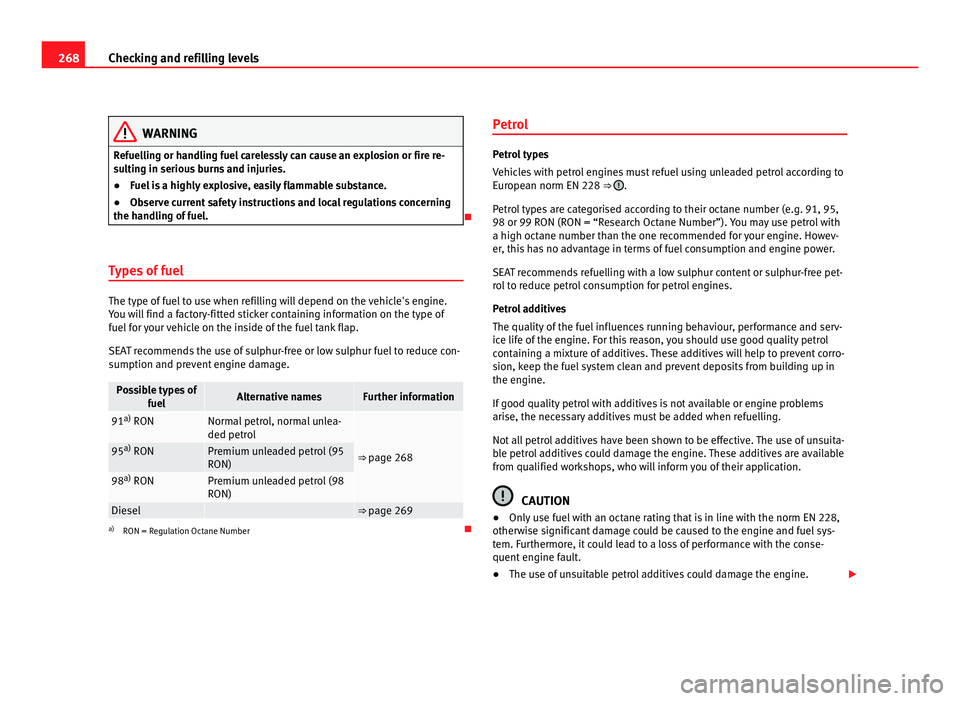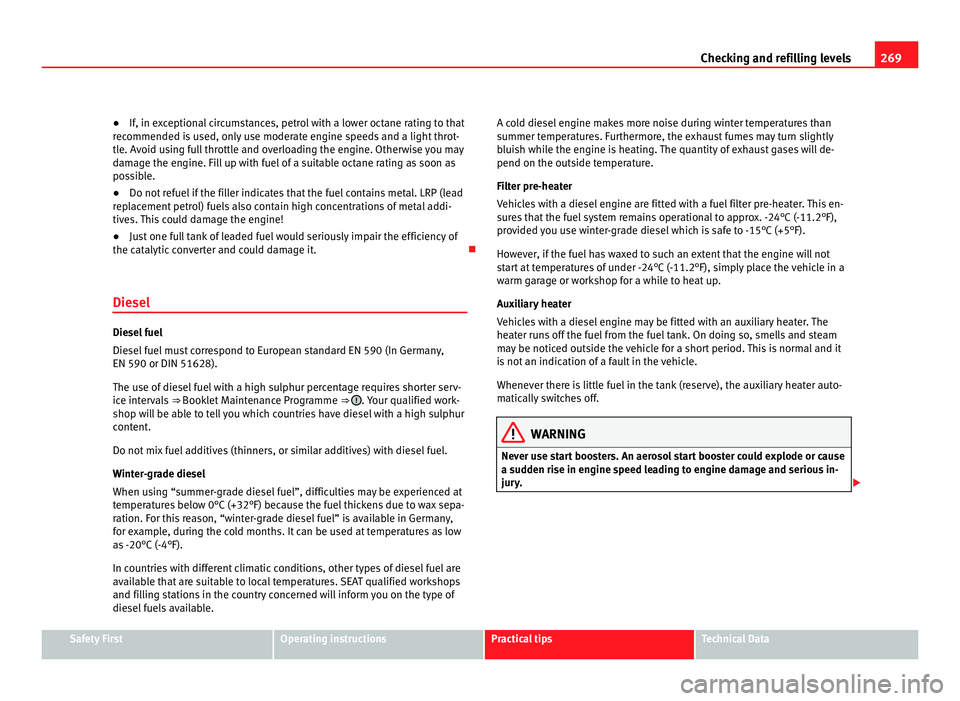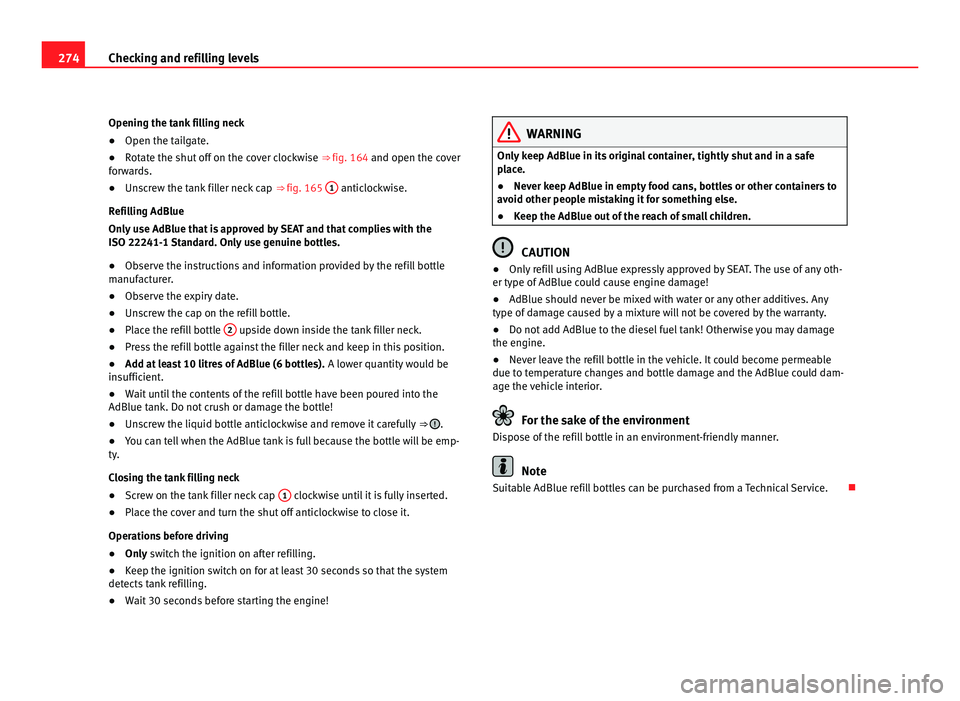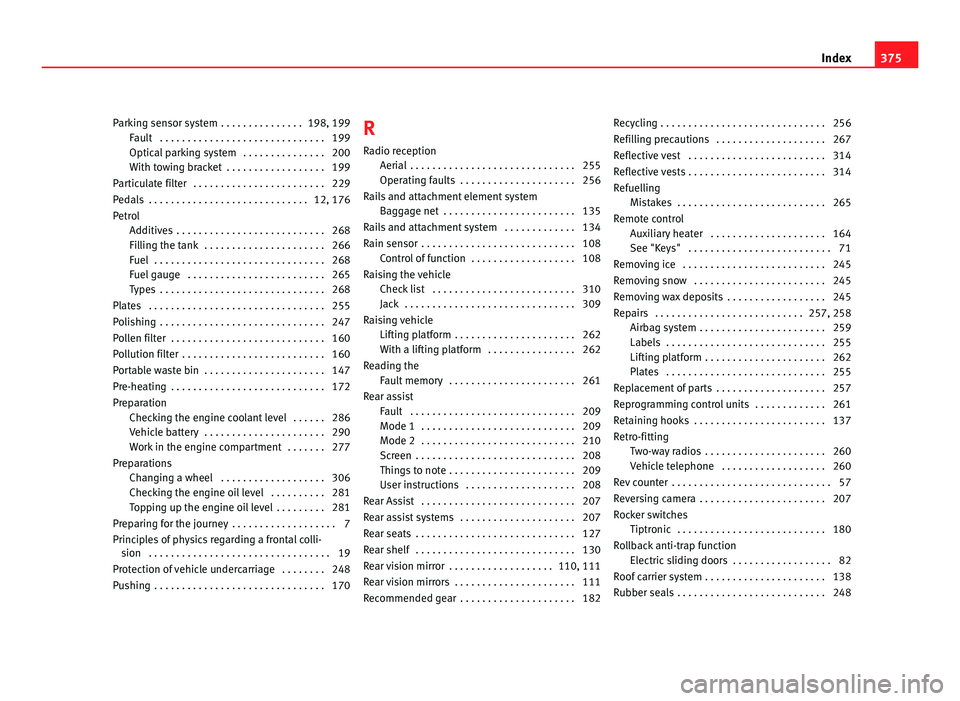fuel additives Seat Alhambra 2011 Owner's Manual
[x] Cancel search | Manufacturer: SEAT, Model Year: 2011, Model line: Alhambra, Model: Seat Alhambra 2011Pages: 385, PDF Size: 7.92 MB
Page 270 of 385

268
Checking and refilling levels WARNING
Refuelling or handling fuel carelessly can cause an explosion or fire re-
su ltin
g in serious burns and injuries.
● Fuel is a highly explosive, easily flammable substance.
● Observe current safety instructions and local regulations concerning
the handling of
fuel.
Types of fuel The type of fuel to use when refilling will depend on the vehicle's engine.
You w
i
ll find a factory-fitted sticker containing information on the type of
fuel for your vehicle on the inside of the fuel tank flap.
SEAT recommends the use of sulphur-free or low sulphur fuel to reduce con-
sumption and prevent engine damage. Possible types of
fuel Alternative names Further information
91
a)
RON Normal petrol, normal unlea-
ded petro
l ⇒ page 26895
a)
RON Premium unleaded petrol (95
RON)
98
a)
RON Premium unleaded petrol (98
RON)
Diesel ⇒ page 269
a)
RON = Regulation Octane Number Petrol Petrol types
Vehic
l
es with petrol engines must refuel using unleaded petrol according to
European norm EN 228 ⇒ .
Petr o
l types are categorised according to their octane number (e.g. 91, 95,
98 or 99 RON (RON = “Research Octane Number”). You may use petrol with
a high octane number than the one recommended for your engine. Howev-
er, this has no advantage in terms of fuel consumption and engine power.
SEAT recommends refuelling with a low sulphur content or sulphur-free pet-
rol to reduce petrol consumption for petrol engines.
Petrol additives
The quality of the fuel influences running behaviour, performance and serv-
ice life of the engine. For this reason, you should use good quality petrol
containing a mixture of additives. These additives will help to prevent corro-
sion, keep the fuel system clean and prevent deposits from building up in
the engine.
If good quality petrol with additives is not available or engine problems
arise, the necessary additives must be added when refuelling.
Not all petrol additives have been shown to be effective. The use of unsuita-
ble petrol additives could damage the engine. These additives are available
from qualified workshops, who will inform you of their application. CAUTION
● Only use fuel with an octane rating that is in line with the norm EN 228,
other w
ise significant damage could be caused to the engine and fuel sys-
tem. Furthermore, it could lead to a loss of performance with the conse-
quent engine fault.
● The use of unsuitable petrol additives could damage the engine.
Page 271 of 385

269
Checking and refilling levels
● If, in exceptional circumstances, petrol with a lower octane rating to that
r ec
ommended is used, only use moderate engine speeds and a light throt-
tle. Avoid using full throttle and overloading the engine. Otherwise you may
damage the engine. Fill up with fuel of a suitable octane rating as soon as
possible.
● Do not refuel if the filler indicates that the fuel contains metal. LRP (lead
repl
acement petrol) fuels also contain high concentrations of metal addi-
tives. This could damage the engine!
● Just one full tank of leaded fuel would seriously impair the efficiency of
the catalytic
converter and could damage it.
Diesel Diesel fuel
Diesel
f
uel must correspond to European standard EN 590 (In Germany,
EN 590 or DIN 51628).
The use of diesel fuel with a high sulphur percentage requires shorter serv-
ice intervals ⇒ Booklet Maintenance Programme ⇒ . Your qualified work-
shop wi l
l be able to tell you which countries have diesel with a high sulphur
content.
Do not mix fuel additives (thinners, or similar additives) with diesel fuel.
Winter-grade diesel
When using “summer-grade diesel fuel”, difficulties may be experienced at
temperatures below 0°C (+32°F) because the fuel thickens due to wax sepa-
ration. For this reason, “winter-grade diesel fuel” is available in Germany,
for example, during the cold months. It can be used at temperatures as low
as -20°C (-4°F).
In countries with different climatic conditions, other types of diesel fuel are
available that are suitable to local temperatures. SEAT qualified workshops
and filling stations in the country concerned will inform you on the type of
diesel fuels available. A cold diesel engine makes more noise during winter temperatures than
summer temper
atures. Furthermore, the exhaust fumes may turn slightly
bluish while the engine is heating. The quantity of exhaust gases will de-
pend on the outside temperature.
Filter pre-heater
Vehicles with a diesel engine are fitted with a fuel filter pre-heater. This en-
sures that the fuel system remains operational to approx. -24°C (-11.2°F),
provided you use winter-grade diesel which is safe to -15°C (+5°F).
However, if the fuel has waxed to such an extent that the engine will not
start at temperatures of under -24°C (-11.2°F), simply place the vehicle in a
warm garage or workshop for a while to heat up.
Auxiliary heater
Vehicles with a diesel engine may be fitted with an auxiliary heater. The
heater runs off the fuel from the fuel tank. On doing so, smells and steam
may be noticed outside the vehicle for a short period. This is normal and it
is not an indication of a fault in the vehicle.
Whenever there is little fuel in the tank (reserve), the auxiliary heater auto-
matically switches off. WARNING
Never use start boosters. An aerosol start booster could explode or cause
a sud den ri
se in engine speed leading to engine damage and serious in-
jury. Safety First Operating instructions Practical tips Technical Data
Page 276 of 385

274
Checking and refilling levels
Opening the tank filling neck
● Open the tailgate.
● Rotate the shut off on the cover clockwise ⇒ fig. 164 and open the cov er
forwards.
● Unscrew the tank filler neck cap ⇒ fig. 165 1 anticlockwise.
Refi l
ling AdBlue
Only use AdBlue that is approved by SEAT and that complies with the
ISO 22241-1 Standard. Only use genuine bottles.
● Observe the instructions and information provided by the refill bottle
manufact
urer.
● Observe the expiry date.
● Unscrew the cap on the refill bottle.
● Place the refill bottle 2 upside down inside the tank filler neck.
● Press the refill bottle against the filler neck and keep in this position.
● Add at least 10 litres of AdBlue (6 bottles). A lower quantity
would be
insufficient.
● Wait until the contents of the refill bottle have been poured into the
AdBlue tank. Do not c
rush or damage the bottle!
● Unscrew the liquid bottle anticlockwise and remove it carefully ⇒ .
● You can tell when the AdBlue tank is full because the bottle will be emp-
ty.
C lo
sing the tank filling neck
● Screw on the tank filler neck cap 1 clockwise until it is fully inserted.
● Place the cover and turn the shut off anticlockwise to close it.
Operation s
before driving
● Only switch the ignition on after refilling.
● Keep the ignition sw
itch on for at least 30 seconds so that the system
detects t
ank refilling.
● Wait 30 seconds before starting the engine! WARNING
Only keep AdBlue in its original container, tightly shut and in a safe
pl ac
e.
● Never keep AdBlue in empty food cans, bottles or other containers to
avoid other peopl
e mistaking it for something else.
● Keep the AdBlue out of the reach of small children. CAUTION
● Only refill using AdBlue expressly approved by SEAT. The use of any oth-
er type of AdBlue c
ould cause engine damage!
● AdBlue should never be mixed with water or any other additives. Any
type of dam
age caused by a mixture will not be covered by the warranty.
● Do not add AdBlue to the diesel fuel tank! Otherwise you may damage
the engine.
● Never l
eave the refill bottle in the vehicle. It could become permeable
due to temper
ature changes and bottle damage and the AdBlue could dam-
age the vehicle interior. For the sake of the environment
Dispose of the refill bottle in an environment-friendly manner. Note
Suitable AdBlue refill bottles can be purchased from a Technical Service.
Page 377 of 385

Parking sensor system . . . . . . . . . . . . . . . 198, 199
Fault
. . . . . . . . . . . . . . . . . . . . . . . . . . . . . . 199
Optical parking system . . . . . . . . . . . . . . . 200
With towing bracket . . . . . . . . . . . . . . . . . . 199
Particulate filter . . . . . . . . . . . . . . . . . . . . . . . . 229
Pedals . . . . . . . . . . . . . . . . . . . . . . . . . . . . . 12, 176
Petrol Additives . . . . . . . . . . . . . . . . . . . . . . . . . . . 268
Filling the tank . . . . . . . . . . . . . . . . . . . . . . 266
Fuel . . . . . . . . . . . . . . . . . . . . . . . . . . . . . . . 268
Fuel gauge . . . . . . . . . . . . . . . . . . . . . . . . . 265
Types . . . . . . . . . . . . . . . . . . . . . . . . . . . . . . 268
Plates . . . . . . . . . . . . . . . . . . . . . . . . . . . . . . . . 255
Polishing . . . . . . . . . . . . . . . . . . . . . . . . . . . . . . 247
Pollen filter . . . . . . . . . . . . . . . . . . . . . . . . . . . . 160
Pollution filter . . . . . . . . . . . . . . . . . . . . . . . . . . 160
Portable waste bin . . . . . . . . . . . . . . . . . . . . . . 147
Pre-heating . . . . . . . . . . . . . . . . . . . . . . . . . . . . 172
Preparation Checking the engine coolant level . . . . . . 286
Vehicle battery . . . . . . . . . . . . . . . . . . . . . . 290
Work in the engine compartment . . . . . . . 277
Preparations Changing a wheel . . . . . . . . . . . . . . . . . . . 306
Checking the engine oil level . . . . . . . . . . 281
Topping up the engine oil level . . . . . . . . . 281
Preparing for the journey . . . . . . . . . . . . . . . . . . . 7
Principles of physics regarding a frontal colli- sion . . . . . . . . . . . . . . . . . . . . . . . . . . . . . . . . . 19
Protection of vehicle undercarriage . . . . . . . . 248
Pushing . . . . . . . . . . . . . . . . . . . . . . . . . . . . . . . 170 R
Radio r eception
Aerial . . . . . . . . . . . . . . . . . . . . . . . . . . . . . . 255
Operating faults . . . . . . . . . . . . . . . . . . . . . 256
Rails and attachment element system Baggage net . . . . . . . . . . . . . . . . . . . . . . . . 135
Rails and attachment system . . . . . . . . . . . . . 134
Rain sensor . . . . . . . . . . . . . . . . . . . . . . . . . . . . 108 Control of function . . . . . . . . . . . . . . . . . . . 108
Raising the vehicle Check list . . . . . . . . . . . . . . . . . . . . . . . . . . 310
Jack . . . . . . . . . . . . . . . . . . . . . . . . . . . . . . . 309
Raising vehicle Lifting platform . . . . . . . . . . . . . . . . . . . . . . 262
With a lifting platform . . . . . . . . . . . . . . . . 262
Reading the Fault memory . . . . . . . . . . . . . . . . . . . . . . . 261
Rear assist Fault . . . . . . . . . . . . . . . . . . . . . . . . . . . . . . 209
Mode 1 . . . . . . . . . . . . . . . . . . . . . . . . . . . . 209
Mode 2 . . . . . . . . . . . . . . . . . . . . . . . . . . . . 210
Screen . . . . . . . . . . . . . . . . . . . . . . . . . . . . . 208
Things to note . . . . . . . . . . . . . . . . . . . . . . . 209
User instructions . . . . . . . . . . . . . . . . . . . . 208
Rear Assist . . . . . . . . . . . . . . . . . . . . . . . . . . . . 207
Rear assist systems . . . . . . . . . . . . . . . . . . . . . 207
Rear seats . . . . . . . . . . . . . . . . . . . . . . . . . . . . . 127
Rear shelf . . . . . . . . . . . . . . . . . . . . . . . . . . . . . 130
Rear vision mirror . . . . . . . . . . . . . . . . . . . 110, 111
Rear vision mirrors . . . . . . . . . . . . . . . . . . . . . . 111
Recommended gear . . . . . . . . . . . . . . . . . . . . . 182 Recycling . . . . . . . . . . . . . . . . . . . . . . . . . . . . . . 256
Refil
ling precautions . . . . . . . . . . . . . . . . . . . . 267
Reflective vest . . . . . . . . . . . . . . . . . . . . . . . . . 314
Reflective vests . . . . . . . . . . . . . . . . . . . . . . . . . 314
Refuelling Mistakes . . . . . . . . . . . . . . . . . . . . . . . . . . . 265
Remote control Auxiliary heater . . . . . . . . . . . . . . . . . . . . . 164
See "Keys" . . . . . . . . . . . . . . . . . . . . . . . . . . 71
Removing ice . . . . . . . . . . . . . . . . . . . . . . . . . . 245
Removing snow . . . . . . . . . . . . . . . . . . . . . . . . 245
Removing wax deposits . . . . . . . . . . . . . . . . . . 245
Repairs . . . . . . . . . . . . . . . . . . . . . . . . . . . 257, 258 Airbag system . . . . . . . . . . . . . . . . . . . . . . . 259
Labels . . . . . . . . . . . . . . . . . . . . . . . . . . . . . 255
Lifting platform . . . . . . . . . . . . . . . . . . . . . . 262
Plates . . . . . . . . . . . . . . . . . . . . . . . . . . . . . 255
Replacement of parts . . . . . . . . . . . . . . . . . . . . 257
Reprogramming control units . . . . . . . . . . . . . 261
Retaining hooks . . . . . . . . . . . . . . . . . . . . . . . . 137
Retro-fitting Two-way radios . . . . . . . . . . . . . . . . . . . . . . 260
Vehicle telephone . . . . . . . . . . . . . . . . . . . 260
Rev counter . . . . . . . . . . . . . . . . . . . . . . . . . . . . . 57
Reversing camera . . . . . . . . . . . . . . . . . . . . . . . 207
Rocker switches Tiptronic . . . . . . . . . . . . . . . . . . . . . . . . . . . 180
Rollback anti-trap function Electric sliding doors . . . . . . . . . . . . . . . . . . 82
Roof carrier system . . . . . . . . . . . . . . . . . . . . . . 138
Rubber seals . . . . . . . . . . . . . . . . . . . . . . . . . . . 248 375
Index